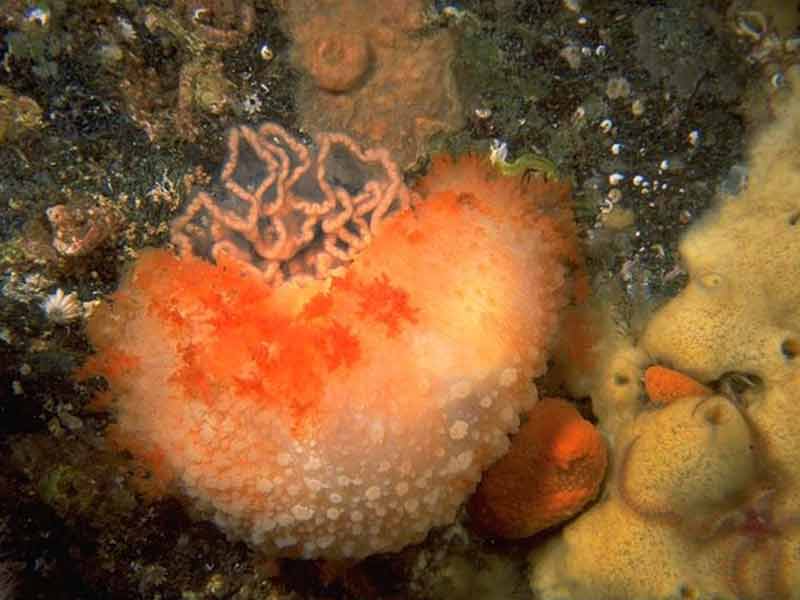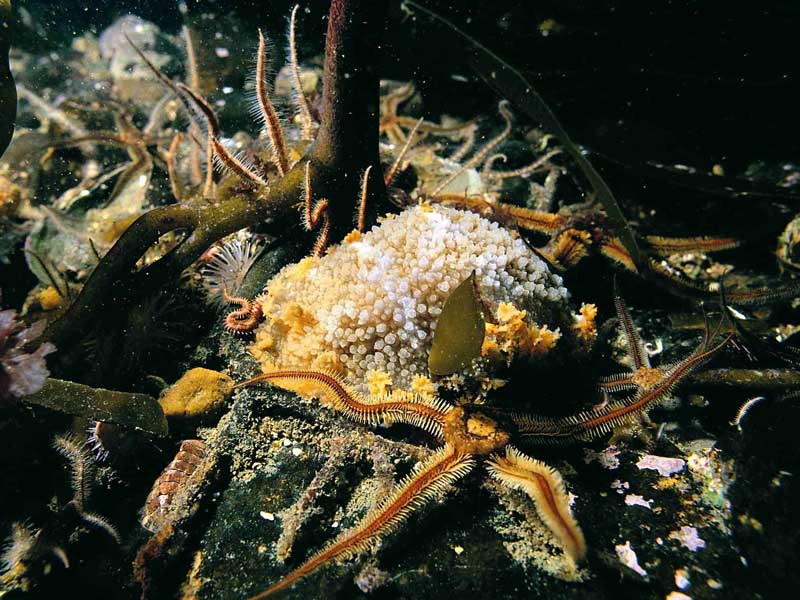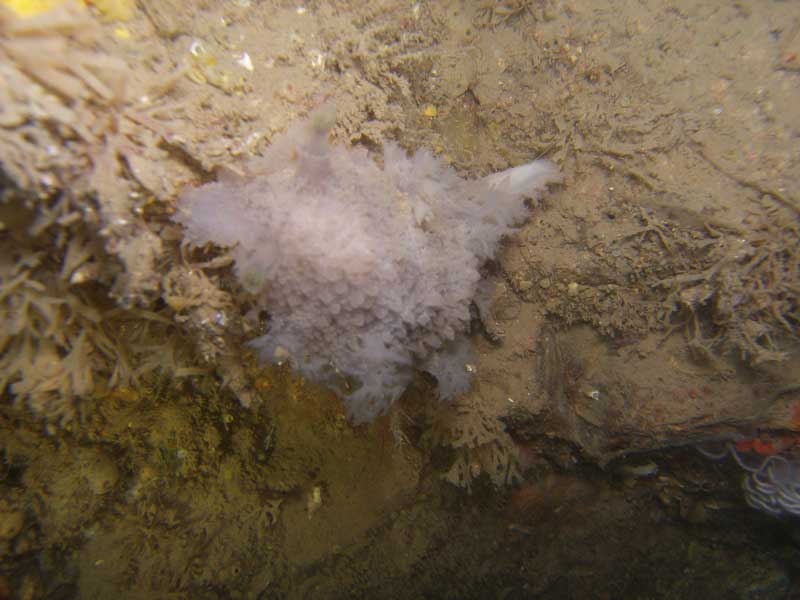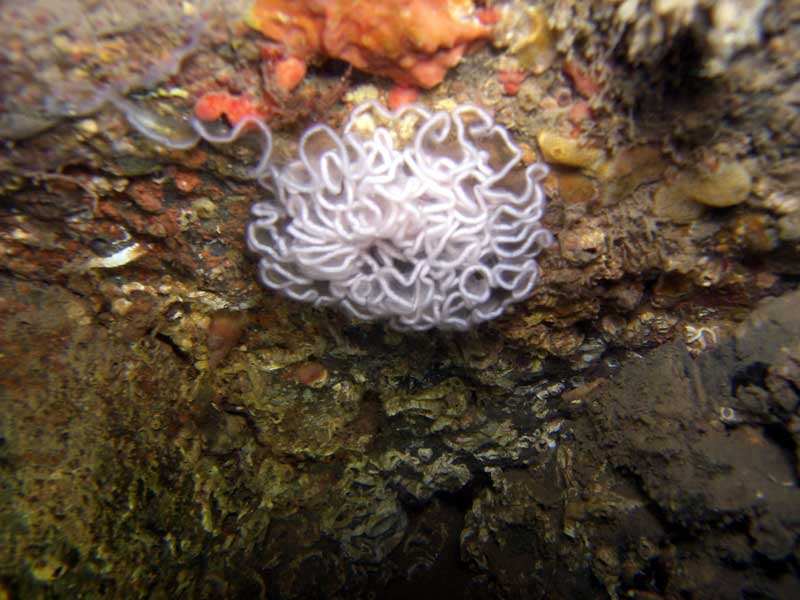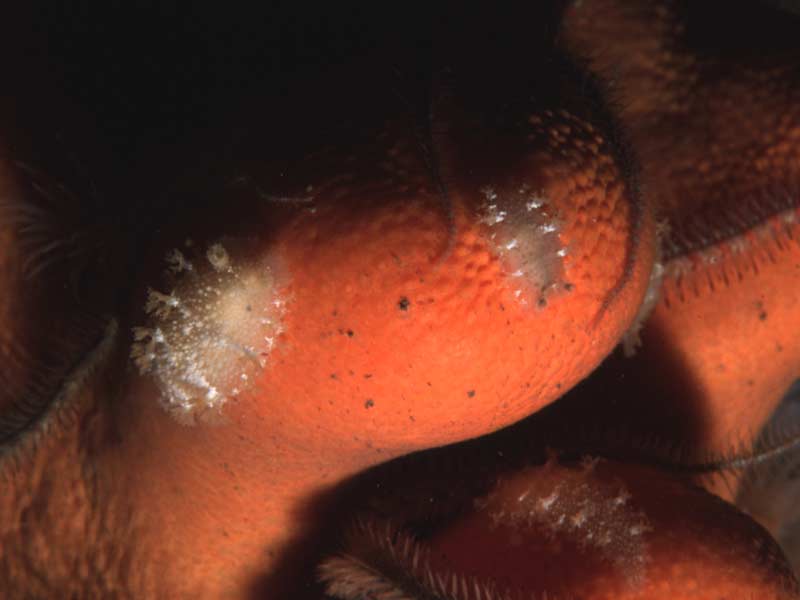A sea slug (Tritonia hombergii)
Distribution data supplied by the Ocean Biodiversity Information System (OBIS). To interrogate UK data visit the NBN Atlas.Map Help
| Researched by | Jessica Heard | Refereed by | Admin |
| Authority | Cuvier, 1803 | ||
| Other common names | - | Synonyms | Tritonia hombergii , Tritonia hombergi |
Summary
Description
Tritonia hombergii is the largest British nudibranch growing up to 20 cm in length. The body varies in colour from white to a dark purple brown and is lighter ventrally (colour darkens with age). The rhinophores are branched at the tip with basal sheaths. The mantle is covered with numerous soft tubercles, which release an irritant compound. On the sides of the upper surface there are noticeable gills, of varying size. The larger gills orientate towards the centre of the body while smaller gills flex out to the side. The total number of individual gills increases significantly with age. The front section of the head (the oral veil) is divided into two lobes and, characteristically for members of the genus Tritonia, each lobe is divided into numerous finger-like projections.
Recorded distribution in Britain and Ireland
Occurs all around the Britain and Ireland
Global distribution
Recorded from the coasts of the British Isles and the Channel coast of France, with scattered records in the North Sea and east into the Skagerrak.
Habitat
Tritonia hombergii can be found down to depths of 80 m and is always associated with the soft coral Alcyonium digitatum.
Depth range
0-80 mIdentifying features
- Body colour white to dark purple
- Rhinophores branched at the tips and have basal sheaths.
- Surface covered in numerous tubercles
- Gills of vary size, large gills point towards centre of body, small gills point outwards.
- Oral veil split into two lobes, each richly frilled.
Additional information
Tritonia hombergii has annual life cycle and the juveniles were once thought to be a different species known as Tritonia alba. Tritonia hombergii is one of the few opisthobranchs thought to be harmful to man as its secretion has been reported to cause the skin to blister. However, there have been no recent recorded evidence of this (Thompson & Brown, 1976).
Listed by
- none -
Bibliography
Hayward, P., Nelson-Smith, T. & Shields, C. 1996. Collins pocket guide. Sea shore of Britain and northern Europe. London: HarperCollins.
Picton, B. E. & Morrow, C.C., 1994. A Field Guide to the Nudibranchs of the British Isles. London: Immel Publishing Ltd.
Thompson, T. E. & Brown, G. H., 1976. British Opisthobranch Molluscs. London: Academic Press. [Synopses of the British Fauna, no. 8.]
Datasets
Centre for Environmental Data and Recording, 2018. Ulster Museum Marine Surveys of Northern Ireland Coastal Waters. Occurrence dataset https://www.nmni.com/CEDaR/CEDaR-Centre-for-Environmental-Data-and-Recording.aspx accessed via NBNAtlas.org on 2018-09-25.
Conchological Society of Great Britain & Ireland, 2018. Mollusc (marine) data for Great Britain and Ireland - restricted access. Occurrence dataset: https://doi.org/10.15468/4bsawx accessed via GBIF.org on 2018-09-25.
Conchological Society of Great Britain & Ireland, 2023. Mollusc (marine) records for Great Britain and Ireland. Occurrence dataset: https://doi.org/10.15468/aurwcz accessed via GBIF.org on 2024-09-27.
Manx Biological Recording Partnership, 2022. Isle of Man historical wildlife records 1990 to 1994. Occurrence dataset:https://doi.org/10.15468/aru16v accessed via GBIF.org on 2024-09-27.
NBN (National Biodiversity Network) Atlas. Available from: https://www.nbnatlas.org.
OBIS (Ocean Biodiversity Information System), 2025. Global map of species distribution using gridded data. Available from: Ocean Biogeographic Information System. www.iobis.org. Accessed: 2025-07-31
Citation
This review can be cited as:
Last Updated: 17/04/2008

